6 Best HubSpot Alternatives and Competitors in 2024
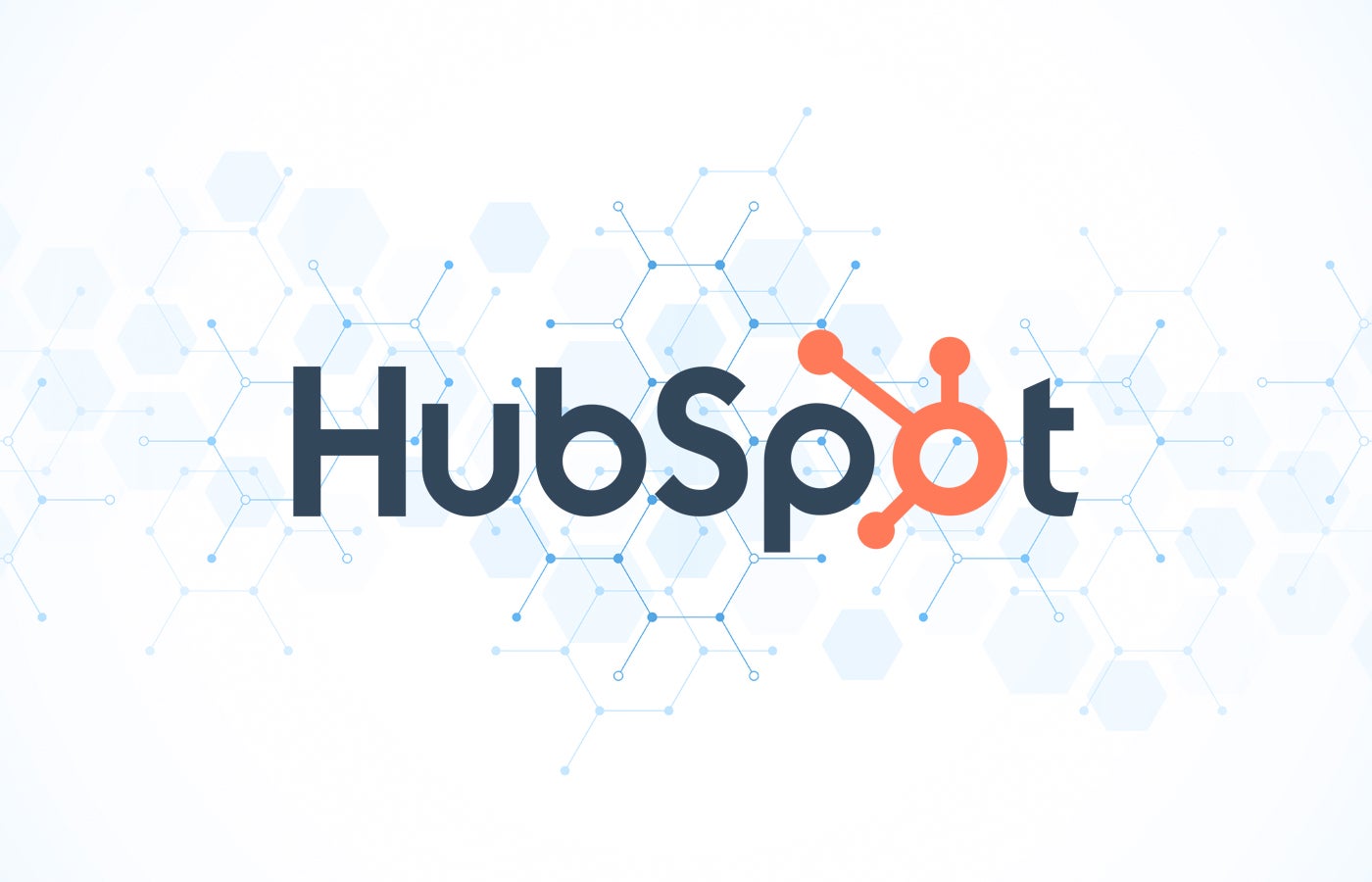
- Best for industry specializations: Pipedrive
- Best for ongoing project management: Monday CRM
- Best for product development: ClickUp
- Best for advanced marketing tools: Zoho CRM
- Best for streamlined task management: Capsule
- Best for integrating with Google Workspace: Copper CRM
HubSpot offers a very popular CRM software, along with a suite of other marketing and service tools. HubSpot’s feature-rich platform helps businesses of a multitude of sizes and industries generate and manage leads from start to finish with the help of native and third-party integrations. It is also known for its free marketing and sales tools like the free meeting scheduler, live chat software, and dashboard and reporting software.
While HubSpot has a mix of core and advanced features, it’s always beneficial to consider similar providers before committing to a solution.
1
monday CRM
Employees per Company Size
Micro (0-49), Small (50-249), Medium (250-999), Large (1,000-4,999), Enterprise (5,000+)
Any Company Size
Any Company Size
Features
Calendar, Collaboration Tools, Contact Management, and more
3
HubSpot CRM
Employees per Company Size
Micro (0-49), Small (50-249), Medium (250-999), Large (1,000-4,999), Enterprise (5,000+)
Micro (0-49 Employees), Small (50-249 Employees), Medium (250-999 Employees), Large (1,000-4,999 Employees)
Micro, Small, Medium, Large
Top HubSpot alternatives comparison
Some of the top alternatives and competitors of HubSpot include Pipedrive, monday CRM, Zoho CRM, and ClickUp. I’ve decided to compare these alternatives to HubSpot’s most competitive offerings, such as the free-for-life version of the software, marketing capabilities, AI-powered tools, and reporting functionality.
| HubSpot | ||||||
| Pipedrive | ||||||
| Monday CRM | ||||||
| ClickUp | ||||||
| Zoho CRM | ||||||
| Capsule | ||||||
| Copper CRM | ||||||
| *Price when billed annually. | ||||||
Pipedrive: Best for industry specializations
Not only can Pipedrive be a solution for startups through enterprises, it can also adapt as a CRM to fit the needs of specific markets and industries. For example, a retail company can use Pipedrive’s features to optimize their operations in person or online, gain product insights, organize customer data, and build out customer loyalty programs. This is also the case for niche industries like consumer manufacturing, automotive sales, healthcare, higher education, nonprofits, recruitment, and architecture.
Why I chose Pipedrive
Pipedrive is a global solution that allows businesses to track existing and forecasted sales pipelines, optimize incoming leads, manage deals with AI-powered tools, and automate the entire sales process so reps can focus on enhancing their customer experience. Pipedrive is an intuitive tool that focuses on tracking deals through pipeline views with custom fields and smart formulas.
Pipedrive and HubSpot both can be customized to fit the needs of a specific industry, but if you want a similar solution with affordable premium tiers plus marketing tools, I recommend checking out monday CRM, Zoho CRM, or Capsule.
For more information, read the full Pipedrive review.
Pricing
- Essential: $14 per user per month, billed annually, or $24 per user when billed monthly.
- Advanced: $34 per user per month, billed annually, or $44 per user when billed monthly.
- Professional: $49 per user per month, billed annually, or $64 per user when billed monthly.
- Power: $64 per user per month, billed annually, or $79 per user when billed monthly.
- Enterprise: $99 per user per month, billed annually, or $129 per user when billed monthly.
Features
- AI summaries: Receive condensed email briefs for reps to grasp the essentials while also reducing work overload.
- Email segmentation: Deploy targeted email marketing campaigns to customers or leads by creating segmented lists to nurture leads closer to a sale.
- Sales pipeline: Create custom pipelines that match the exact stages of your business’ sales stages.

Pros and cons
| Pros | Cons |
|---|---|
|
|
Monday CRM: Best for ongoing project management

monday CRM is an intuitive solution that helps businesses store data and information with no-code automations. Users can quickly import data from Excel or API directly into the CRM software, then monday CRM will eliminate overlap of duplicate data. From there, activity management like calls, meetings, and notes are automatically stored. Individual reps or sales managers can keep track of projects, general pipelines, new targets, and team performance from one view.
Why I chose monday CRM
monday CRM is an operational CRM that can automate workflows and tasks while also acting as a central hub for all customer and sales data. With AI-powered tools, robust integrations, and an emphasis on team collaboration, users can manage progress across departments. monday CRM is also a very scalable tool that can be used by companies of any size, from small businesses to enterprises.
While monday CRM can provide a free version of its tool, it is on a case-by-case basis that requires an approved application. If you want an alternative to HubSpot that also has a free version of the tool, I recommend Zoho CRM or Capsule.
For more, head over to the monday CRM review.
Pricing
- Free version: Basic CRM offerings are only available for students and nonprofit organizations after submitting an application.
- Basic CRM: $12 per user per month when billed annually, or $15 when billed monthly.
- Standard CRM: $17 per user per month when billed annually, or $20 when billed monthly.
- Pro CRM: $28 per user per month when billed annually, or $33 when billed monthly.
- Enterprise CRM: Contact monday.com for a quote.
Features
- Email composition: Receive AI-generated email copy and save suggested templates for quick client outreach.
- Custom automation: Assign leads, set reminders, and get notifications based on preset sales automations.
- Deal pipeline: Customize multiple pipelines without any technical expertise with simple drag-and-drop stages, automations, and activity tracking.
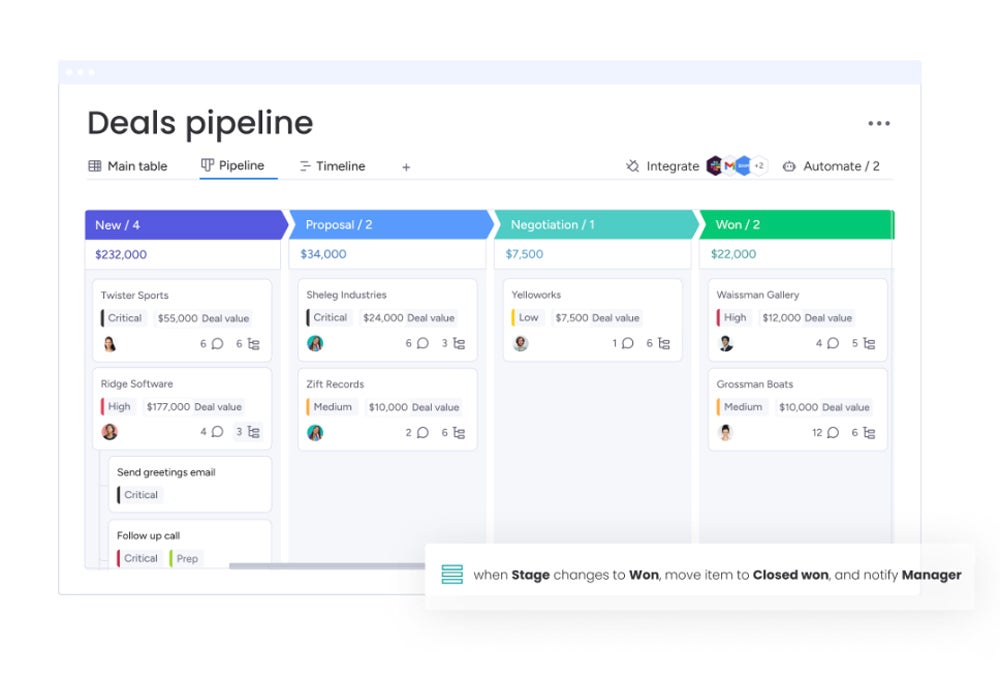
Pros and cons
| Pros | Cons |
|---|---|
|
|
ClickUp: Best for product development

With the unique product development functionality of ClickUp, users can build and automate any sprint cycle. Users have access to sprint reports, kanban views, custom roadmaps, and backlog trackers — all to optimize product development and create an agile workflow. Preset templates help both non-software and software development teams optimize the same software the sales and marketing departments use for enhanced collaboration.
Why I chose ClickUp
ClickUp markets itself as an all-in-one software that offers CRM functionality. The product itself comes with a mix of features for project management, product development, knowledge and resource management, and collaboration. ClickUp offers all of these features with the goal to help businesses improve collaboration, enhance visibility across departments, and automate a lot of the more tedious work.
While ClickUp offers affordable plans, there are some limitations around its marketing and lead generation capabilities. If that’s something you’re after when considering HubSpot alternatives, I suggest Zoho CRM.
Pricing
- Forever Free: Free for unlimited users, allowing up to 100 MB of storage, collaborative docs, real-time chat, and more.
- Unlimited: $7 per user, per month when billed annually or $10 when billed monthly.
- Business: $12 per user, per month when billed annually or $19 when billed monthly.
- Enterprise: Contact ClickUp directly for a quote.
Features
- Docs: Create and collaborate on documents as a group that automatically save with privacy and sharing controls.
- Time tracking: Track individual rep time across any mobile device with the free Chrome extension, no matter which integrated tool is being used.
- Sprint reports: View digestible reporting dashboards that can measure personal productivity, team workloads, software sprints, marketing campaigns, sales overviews, and so much more.
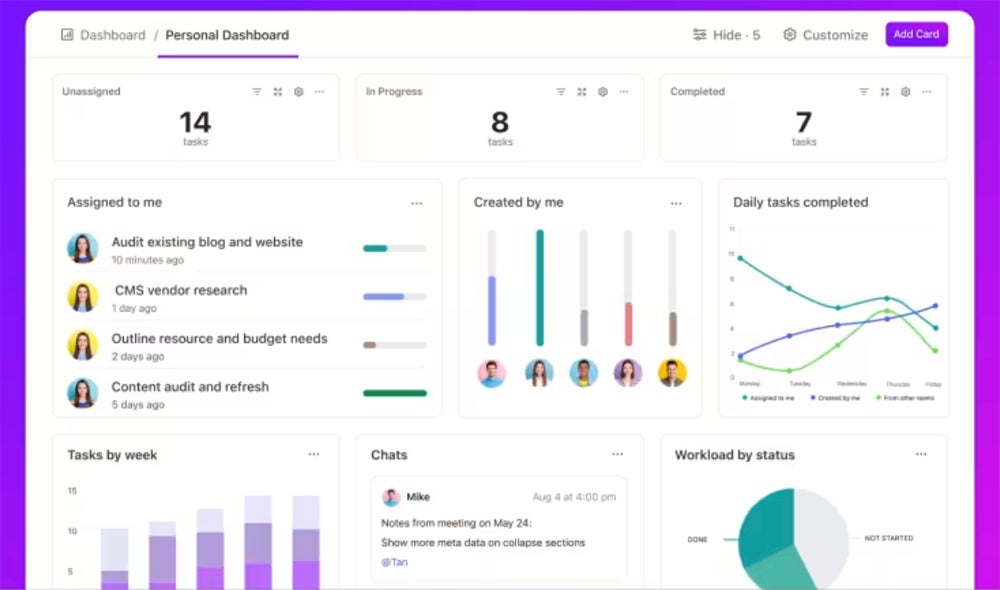
Pros and cons
| Pros | Cons |
|---|---|
|
|
Features
- Zia: Receive information, generate content, have notes, and even predictive analytics from Zoho’s AI assistant, Zia.
- Omnichannel communication: Interact with customers through multiple channels such as email, telephone, social media, SMS, live chat, WhatsApp, webforms, and even a self-service portal.
- Event management: Manage events by sending online invitations or follow-ups, organizing meetings, and even tracking results from within the CRM.
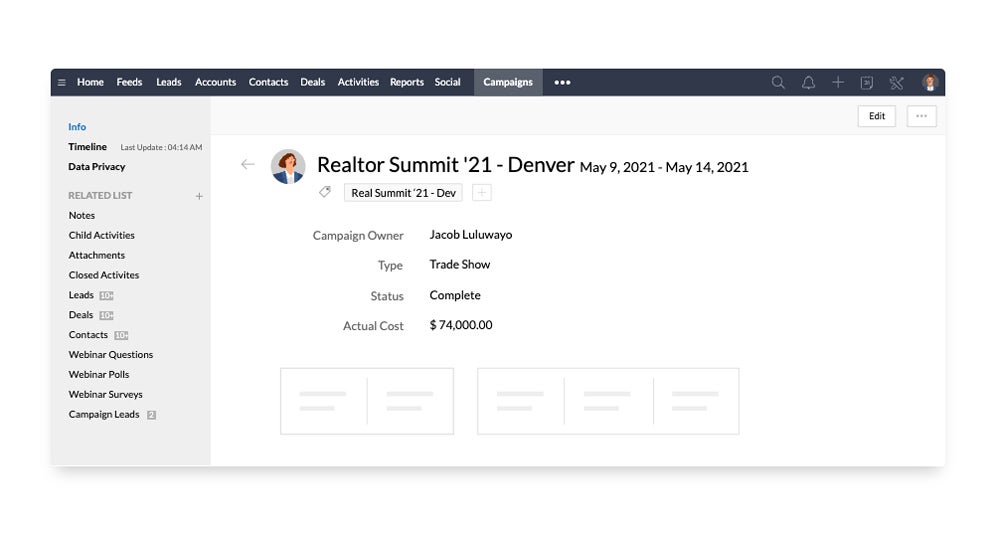
Pros and cons
| Pros | Cons |
|---|---|
|
|
Capsule: Best for streamlined task management

Capsule offers a variety of task management tools that help reps manage their day-to-day workflows. A major benefit of a CRM solution is that it helps sales reps or managers efficiently handle customer relationships, and task management does a lot of that heavy lifting. Some of Capsule’s task management features include task reminder emails, repeating task notifications, automations, and calendar views.
Why I chose Capsule
Capsule is an intuitive CRM that markets itself as a solution best for small businesses because of no onboarding fees and quick system setup. Features include contact and project management, workflow automations, and sales analytics. Capsule also offers integrations through Zapier and Make.
Capsule is an affordable solution for startups or small to mid-sized companies who are after an intuitive online CRM. I recommend Zoho CRM or HubSpot if you want a platform to manage a larger number of users.
Read my Capsule review for more details.
Pricing
- Free tier: Free for up to 250 contacts and 50MB of storage per account.
- Starter: $18 per user per month when billed annually, or $21 per user when billed monthly.
- Growth: $36 per user per month when billed annually, or $38 per user when billed monthly.
- Advanced: $54 per user per month when billed annually, or $60 per user when billed monthly.
- Ultimate: $72 per user per month when billed annually, or $75 per user when billed monthly.
Features
- AI content assistant: Generate relevant emails for clients with AI that reps can copy, re-edit, and tweak as needed.
- Sales pipeline forecasting: Monitor pipeline health between pipeline forecast by anticipated growth, team, and project owner.
- Task automation: Set a series of tasks that trigger each other for automated follow up.
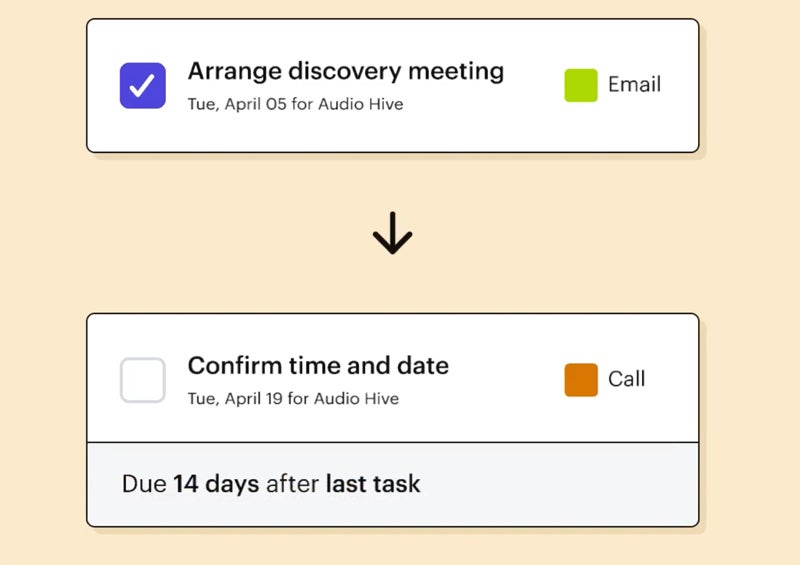
Pros and cons
| Pros | Cons |
|---|---|
|
|
Copper CRM: Best for integrating with Google Workspace
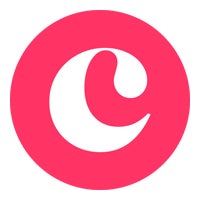
Copper CRM integrates seamlessly with the entire Google Workspace suite. The modern CRM can sync with your Gmail, Calendar, and Drive so that sales reps can access information without having to jump between tools. Cooper is a Chrome Enterprise Partner and can even help with lead generation by creating new profiles in the CRM based on Gmail activity. This is best for businesses looking for a CRM solution and who already subscribe to Google Workspace tools.
Why I chose Copper CRM
Copper is a CRM solution that focuses on creating a complete view of business relationships, promoting collaboration, and visualizing the entire customer journey for reps. It’s relatively simple to set up for small to mid-sized businesses. It also offers specific solutions for industries like financial services, consulting, real estate, and corporate development.
While Copper’s Starter and Basic tiers are affordable compared to industry standards, it doesn’t have a free plan. If access to a free tier, as well as more advanced AI functionality, are priorities for you, I recommend HubSpot over Copper.
Pricing
- Starter: $9 per seat, per month when billed annually. $12 per seat, per month when billed monthly.
- Basic: $23 per seat, per month when billed annually. $29 per seat, per month when billed monthly.
- Professional: $59 per seat, per month when billed annually. $69 per seat, per month when billed monthly.
- Business: $99 per seat, per month when billed annually. $134 per seat, per month when billed monthly.
Features
- Sales pipelines: Track and sort deals by their value amounts and monitor win probabilities with the customizable drag-and-drop sales pipeline builder.
- Mobile app: Access all customer data and activity while on the go by logging calls, sending messages, and updating team members.
- Email sequences: Build automated nurture email sequences to follow up with leads based on their account status or website engagement through the Gmail integration.
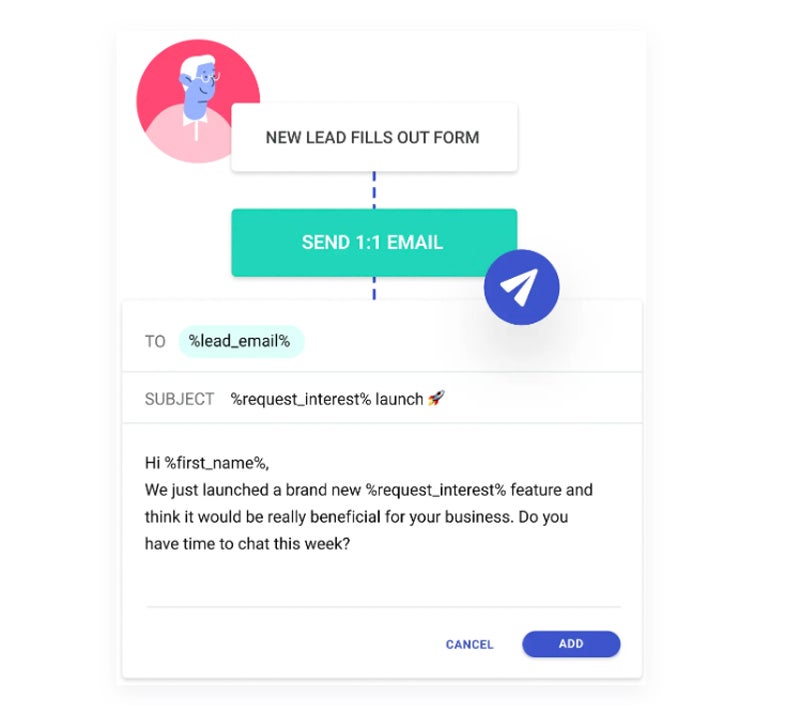
Pros and cons
| Pros | Cons |
|---|---|
|
|
Do you need an alternative to HubSpot?
Some HubSpot drawbacks pointed out by real users include how expensive the premium plans can be, limited live customer support and customization options, and overall ease of use.
I recommend getting a better understanding of how CRM pricing works and knowing what your allocated budget is, as well as what your industry standards are for use of a CRM tool. Next, follow our guide to choosing a CRM to ensure the implementation process and ongoing support sets up your business for real long-term success.
If you want a deeper understanding of HubSpot’s offerings, check out our independent HubSpot review.
Methodology
When reviewing general CRM providers in comparison to HubSpot, I used an in-house rubric with outlined criteria of CRM industry standards. After each provider is processed through this rubric, an algorithm calculates an overall rating, and I use that to identify an ideal use case for each software.
Here’s the exact breakdown of the criteria I followed:
- Cost: Weighted 25% of the total score.
- Core features: Weighted 25% of the total score.
- Customizations: Weighted 15% of the total score.
- Integrations: Weighted 15% of the total score.
- Ease of use: Weighted 10% of the total score.
- Customer support: Weighted 10% of the total score.
Source link







